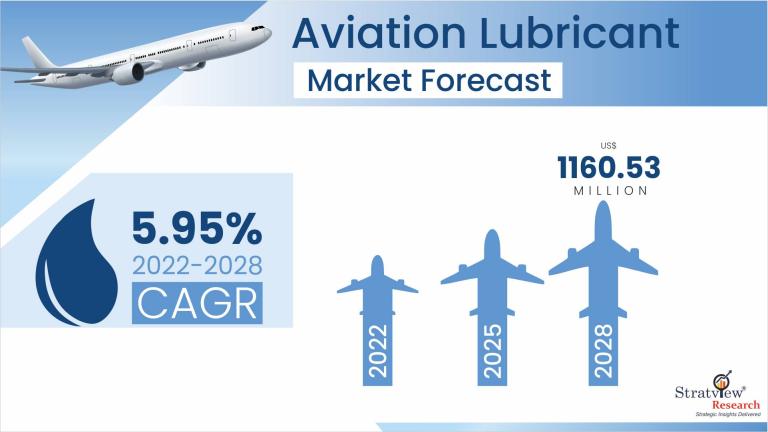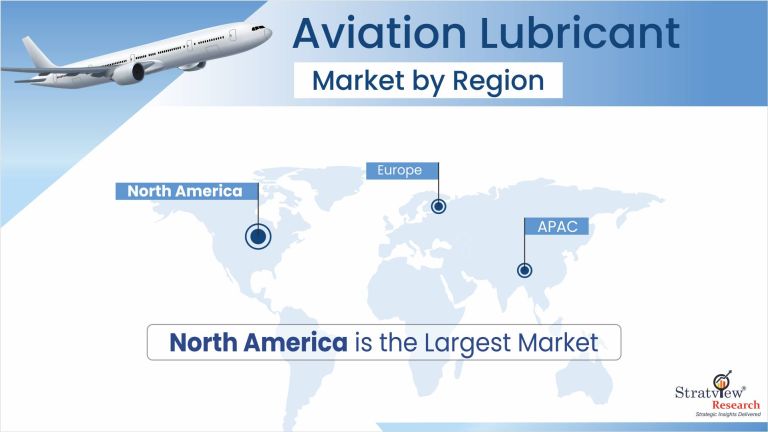Aviation Lubricant Market Insights
"The global aviation lubricant market is estimated to grow from US$ 820.08 million in 2022 to US$ 1160.53 million in 2028 and is likely to grow at a CAGR of 5.95% over the next five years."

Want to get a free sample? Register Here
Introduction
Aviation lubricant is a lubricant used at different temperatures for various applications such as gears, engine cylinder walls, sockets, push rods, camshafts, and similar others in aircraft. The function of the lubricant here is to provide cooling and cleanliness to the engine along with corrosion inhibition.
Aviation lubricant can be mineral-based or synthetic. Hydraulic fluid, grease, engine oil, and special lubricants are some of the lubricant types used. Some of the important application areas where aviation lubricants are being used are hydraulic systems, landing gear, engines, airframes, and others.
Unprecedented growth is owing to rising aircraft orders driven by the snowballing passenger traffic globally. Escalating attention to the improved efficiency of aircraft systems is also driving the growth of the global aviation lubricant market.
|
Aviation Lubricant Market: Snapshot
|
|
Growth
|
5.95% during 2022-2028
|
|
Major Type
|
Engine oil
|
|
Major Aviation Type
|
Military
|
|
Dominant Technology Type
|
Synthetic
|
|
Dominant End-User Type
|
MRO
|
|
Leading Application Type
|
Engine
|
|
Region with the highest demand
|
North America
|
|
Key Players
|
BP plc, Candan Industries, Eastman Chemical Company, Exxon Mobil Corporation, Lanxess Aktiengesellschaft, The PJSC Lukoil Oil Company, The Phillips 66 Company, The Chemours Company, Royal Dutch Shell, and Nye Lubricants Inc.
|
Aviation Lubricant Market Dynamics
Aviation Lubricant Market Drivers
Increasing Aircraft Traffic and Active Fleet
The global increase in air passenger traffic is leading airlines and operators to expand their fleet to meet the rising demand for air travel. According to the Airports Council International (ACI), the global air passenger traffic is projected to exceed 12 billion by 2030. As a result, the need for new, efficient, and sophisticated aircraft having integrated subsystems is increasing, accelerating the aviation lubricant market enormously.
Increasing aircraft deliveries
Aircraft OEMs and MROs require advanced formulations in next-gen systems and regulatory-driven demand for fuel-efficient, SAF-compatible solutions, demanding aviation lubricants widely. The growing aircraft deliveries now and in the future further drive the global aviation lubricant market. For instance, Airbus forecasts >42,000 new aircraft deliveries to be delivered between 2024-2043.
Defence and military investments
With the rise in geopolitical tensions there’s a global trend for governments to increase their defence budget. According to the U.S. Department of Defence, there’s an increase in military aircraft spending due to the exceptional developments in the aviation industry. Moreover, the 2025 U.S. defence budget outlines significant investments in next-gen fighter jets, unmanned aerial systems (UAS), and other advanced military aircraft, all requiring aircraft lubricants to maximize operational effectiveness. The increasing defence investments are certainly contributing to the growth of the aviation lubrication market.
Market Challenges
Stringent Regulations
The aviation industry is highly regulated due to safety concerns, and lubrication is crucial for ensuring the reliable functioning of aircraft engines and components. Unlike industrial and other lubricants, aviation lubricants possess higher requirements in order to perform in extreme conditions. To fulfil this requirement, lubricants must meet strict safety, performance and environmental standards set up by the regulatory bodies. For instance, the Federal Aviation Administration (FAA) has a set of disciplines including identification and mitigation of aviation safety and security risk related to propulsion lubricants, that has to be followed by the aviation lubricant manufacturers for scaling their product globally.
Aviation Lubricant Market Opportunities
Prioritizing sustainable aviation lubricants
To reduce the operational cost and meet the sustainability goals, companies are investing in research and development to create an eco-friendly aviation options including Sustainable Aviation Fuel (SAF). Development of sustainable and eco-friendly lubricants, which in turn, providing new opportunities for the aviation lubricant market worldwide. Aligning with government sustainable norms and policies create a scope of profitability, positioning manufactures as the key players of the aviation lubricant market in near future.
Segments' Analysis
By Type
"The engine oil segment accounted for the largest market share."
Based on the type, the market is segmented as hydraulic fluid, engine oil, grease, and special lubricants and additives. The engine oil segment is estimated to register the highest growth in the coming five years. The growth of this segment is owing to the progression of advanced aircraft engines and the rise in the commercial aircraft fleets.
Aviation Trends
"The military aviation segment accounted for the largest market share."
Based on the type of aviation, the market is segmented as commercial aviation, military aviation, and business and general aviation. The military aviation segment is expected to witness the highest growth during the forecast period. The growth of this segment is fueled by the rising number of aircraft orders for military aviation across the globe.
Technology Trends
"The synthetic segment accounted for the largest market share."
Based on the technology type, the market is segmented as mineral-based and synthetic. The synthetic segment is expected to register a higher growth during the forecast period. This growth can be attributed to the growing demand for advanced lubricants to improve the performance of an aircraft.
End-User Trends
"The MRO segment accounted for the largest market share."
Based on the end-user type, the market is segmented as OEM and MRO. The MRO segment was estimated to remain dominant during the forecasst period. The growth of this segment is owing to the rise in the aircraft fleet of the emerging economies in the commercial and military aviation sectors, during the forecast period.
Application Trends
"The engine segment accounted for the largest market share."
Based on the application type, the market is segmented into hydraulic systems, engines, landing gears, airframes, and others. The engine segment was estimated to impose the aviation lubricant market during the forecast period. The growth of this segment was attributed to the increase in the use of specialized and advanced lubricants.
Regional Insights
"North America accounted for the largest market share."
In terms of regions, North America was estimated to remain dominant in the global aviation lubricant market in 2021. Giant commercial and military aircraft manufacturers, like Boeing (US) and Lockheed Martin (US), are based in North America. Also, the region holds the largest aircraft fleet in the world and thus creates a huge demand for aviation lubricant products. Europe and Asia-Pacific are also expected to offer substantial growth opportunities during the forecast period.

Want to get a free sample? Register Here
Key Players
Some of the major players in the aviation lubricant market are:
Note: The above list does not necessarily include all the top players of the market.
Are you the leading player in this market? We would love to include your name. Write to us at [email protected]
Report Features
This report provides market intelligence in the most comprehensive way. The report structure has been kept such that it offers maximum business value. It provides critical insights into market dynamics and will enable strategic decision-making for existing market players as well as those willing to enter the market.
What deliverables will you get in this report?
|
Key questions this report answers
|
Relevant contents in the report
|
|
How big is the sales opportunity?
|
In-depth analysis of the Aviation Lubricant Market
|
|
How lucrative is the future?
|
Market forecast and trend data and emerging trends
|
|
Which regions offer the best sales opportunities?
|
Global, regional and country level historical data and forecasts
|
|
Which are the most attractive market segments?
|
Market segment analysis and forecast
|
|
Which are the top players and their market positioning?
|
Competitive landscape analysis, Market share analysis
|
|
How complex is the business environment?
|
Porter’s five forces analysis, PEST analysis, Life cycle analysis
|
|
What are the factors affecting the market?
|
Drivers & challenges
|
|
Will I get the information on my specific requirement?
|
10% free customization
|
The aviation lubricant market is segmented into the following categories:
By Type:
- Hydraulic Fluid
- Engine Oil
- Grease
- Special Lubricants and Additives
By Aviation Type:
- Commercial Aviation
- Military Aviation
- Business and General Aviation
By Technology Type:
By End-User Type:
By Application Type:
- Hydraulic Systems
- Engine
- Landing Gear
- Airframe
- Others
By Region:
- North America (Country Analysis: the USA, Canada, and Mexico)
- Europe (Country Analysis: Germany, France, the UK, Russia, and Rest of Europe)
- Asia-Pacific (Country Analysis: China, Japan, India, and Rest of Asia-Pacific)
- Rest of the World (Sub-Region Analysis: Latin America, the Middle East, and Others)
This report studies the market covering a period of 12 years of trend and forecast. The report provides detailed insights into the market dynamics to enable informed business decision making and growth strategy formulation based on the opportunities present in the market.
|
Aviation Lubricant Market Research Report: Features
|
|
Market Segmentation
|
6
|
|
Regions Covered
|
4
|
|
Countries/Sub-Regions Covered
|
15
|
|
No. of Figures & Tables
|
>150
|
|
Company Profiles
|
10
|
Research Methodology
This strategic assessment report from Stratview Research provides a comprehensive analysis that reflects today’s aviation lubricant market realities and future market possibilities for the forecast period. The report segments and analyzes the market in the most detailed manner in order to provide a panoramic view of the market. The vital data/information provided in the report can play a crucial role for market participants as well as investors in the identification of the low-hanging fruits available in the market as well as to formulate growth strategies to expedite their growth process.
This report offers high-quality insights and is the outcome of a detailed research methodology comprising extensive secondary research, rigorous primary interviews with industry stakeholders, and validation and triangulation with Stratview Research’s internal database and statistical tools. More than 1,000 authenticated secondary sources, such as company annual reports, fact books, press releases, journals, investor presentations, white papers, patents, and articles, have been leveraged to gather the data. We conducted more than 15 detailed primary interviews with market players across the value chain in all four regions and industry experts to obtain both qualitative and quantitative insights.
Customization Options
With this detailed report, Stratview Research offers one of the following free customization options to our respectable clients:
Company Profiling
- Detailed profiling of additional market players (up to 3 players)
- SWOT analysis of key players (up to 3 players)
Competitive Benchmarking
- Benchmarking of key players on the following parameters: Product portfolio, geographical reach, regional presence, and strategic alliances
Custom Research: Stratview Research offers custom research services across sectors. In case of any custom research requirement related to market assessment, competitive benchmarking, sourcing and procurement, target screening, and others, please send your inquiry to [email protected].

